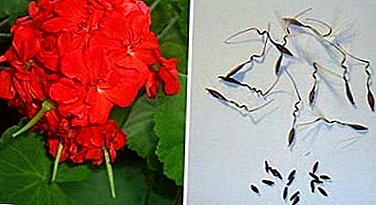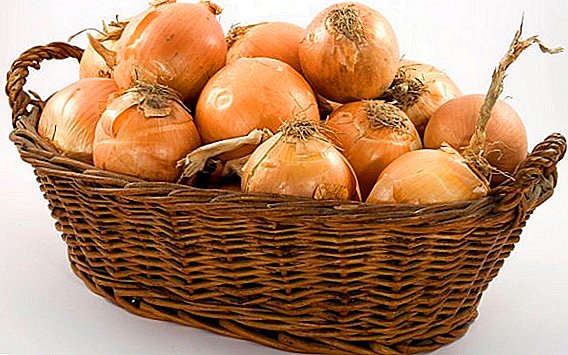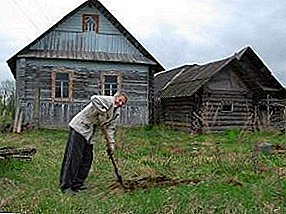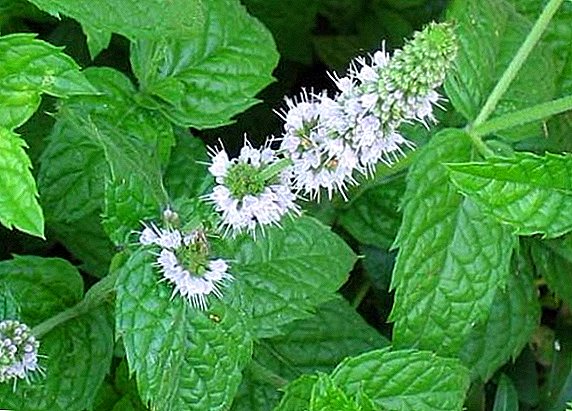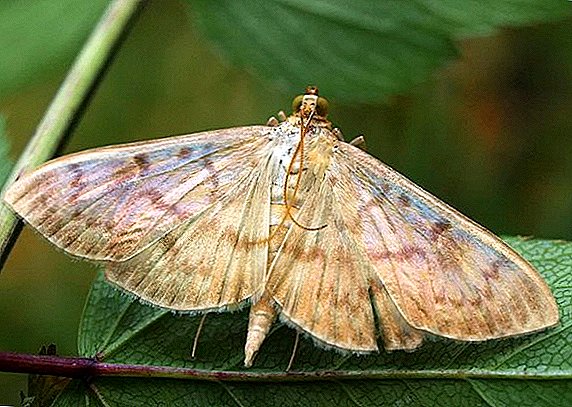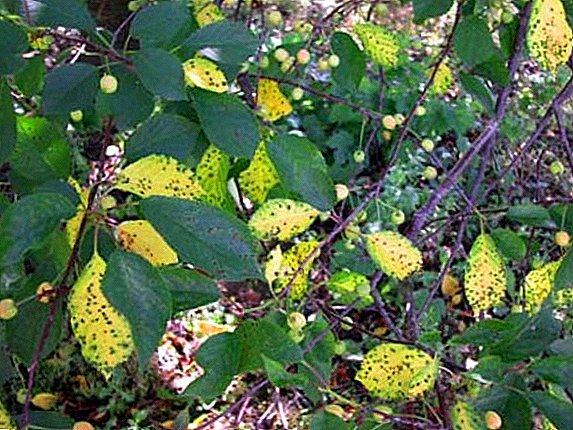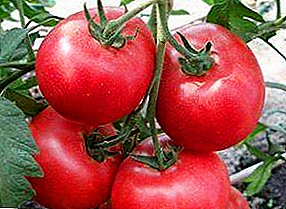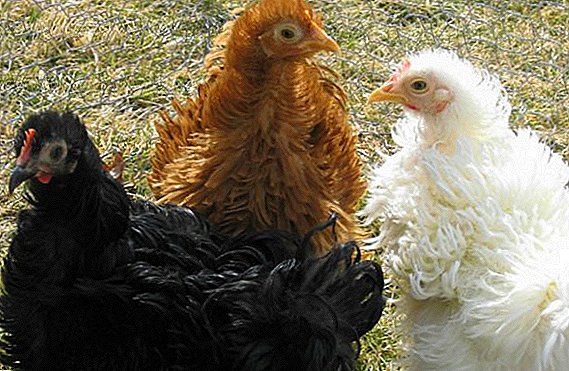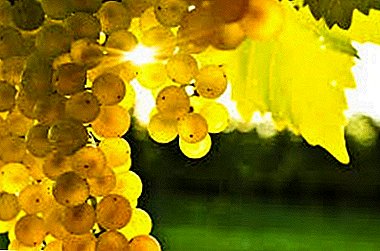
Like any brilliant creation of nature, the vine is constantly subjected to aggression micro and macroorganismsaimed to parasitize on the supply of its vitality.
These are viruses and bacteria, spore-forming fungi, insects and birds. And only a person is able to help a grateful plant to survive in this struggle for survival.
What conditions lead to disease?
Spectrum of hazards for grapes:
- Complicated conditions growth (depleted soil, drought, low temperatures at night and in winter, prolonged rains, strong wind).
- Low agrofone (lack of watering, fertilizing, excess or lack of trace elements in the soil, irregular pruning, weeding, lack of support, violation of the harvest time).
- Insect pests, parasitic on roots, leaves, stalks and fruits of a plant.
- Spore-forming organisms, causing fungal infections, leading to the depletion of the vital forces of the plant and dying.
- Unicellular organisms - bacteria that cause diseases of various organs of the vine.
- The tiniest non-cellular pathogens - viruses.
Berries of grapes effectively stimulate the human immune system, and the person in the process of selection is trying to improve plant immunity to various types of diseases typical for this culture.
Grape bacteriosis
 Bacteria are the oldest unicellular organisms on Earth that became known to man only in the 19th century and were classified as harmful and beneficial. Their representation in the environment is immeasurable. Their feature is "world citizenship".
Bacteria are the oldest unicellular organisms on Earth that became known to man only in the 19th century and were classified as harmful and beneficial. Their representation in the environment is immeasurable. Their feature is "world citizenship".
Bacteria move with flagella, sink and float in liquids, and often create associations. By interaction with the air they are distinguished as aerobic and anaerobic.
They have several types of reproduction: by dividing or primitive sexual process. Moreover, the speed of their reproduction and settlement is so high that infection with pathogenic bacteria occurs in a matter of hours.
Depending on the shape of the bacteria, they choose a certain method of attachment to the surface of the donor’s body to absorb nutrients. If there is a shortage of them, the pathogen, in an attempt to increase the nutrition area, creates new growths - outgrowths. Combining in colonies, microorganisms exist as a biofilm of inaccessible effects of drugs.
The causative agents of bacteriosis in grapes are:
- bacteriaceae - family of saprophytic, numbering more than 100 species; well preserved in soil, water, on plants;
- pseudomonadaceae - mobile soil microorganisms, plant pathogens; synthesize a fluorescent pigment, which makes their presence noticeable; common everywhere;
- mycobacteriaceae - rod-like, branching in young plants pathogens, live in the soil; resistant to alcohols and acids.
In order to develop a control strategy, the pathogens of grapes are identified using methods:

- serological (analysis of immune responses of antibodies);
- biochemical (analysis of the metabolism of bacteria using indicators);
- physiological (analysis of the method of nutrition and metabolism);
- parasitological (analysis of the specificity of donor selection);
- morphological (analysis of the structure and organization of bacterial cells).
Bacterial contamination characterized as:
- seasonal;
- chronic.
A characteristic sign of bacteriological contamination of a plant is the specific pigmentation of leaves, berries, ridges and stalks. The gates for infection are mechanical punctures of the leaf or berry surface, as well as damage caused by insects.
A photo




Symptoms of lesions, their types and control measures
- Bacterial necrosis (Bacterial wilt, Oleiron disease) - a disease of the ground part of the bush. The disease may, after a long-term latent period of vital activity of bacteria, manifest itself as an outbreak triggered by early spring frosts.
Signs of defeat:
- the appearance of black spots pressed into the body of the sheet, with a pronounced brown border;
- alternation in the inflorescences of normal flowers and darkened;
- the lifelessness of the lower buds at the beginning of the growing season, the upper ones give small leaves with signs of chlorosis (yellowing);
- fragility in the nodes (as a result of acquired fragility) of young shoots;
- drying of shoots.
Control measures:
- treatment with 5% solution of Bordeaux liquids or sulfur preparations at the first signs of infection;
- repeated treatment with the same solution, but 2% concentration, after the appearance of the leaves;
- hopelessly affected bushes are recommended to be uprooted.
Necrosis can be caused by a deficiency in potassium and magnesium in the soil, frost, and exposure to toxic smoke. In this case, the necrosis is considered as non-infectious, and its elimination can provide a change in the agrophone.
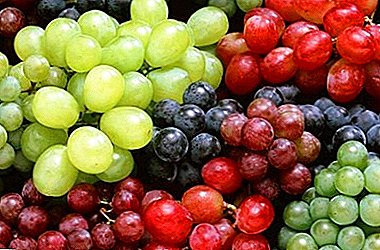 Berry bacteriosis is a disease of fruits from the earliest period of their formation (the integrity of the skin does not matter).
Berry bacteriosis is a disease of fruits from the earliest period of their formation (the integrity of the skin does not matter).Infection of berries occurs selectively, without affecting the whole brush, at the stage of maturation a new infection is no longer relevant. Danger threatens with hot weather, primarily berries grapes from the sunny side of the bush.
Signs of defeat:
- the appearance under the skin of still hard berries of a small light yellow spot;
- the transformation of the spot in the deepening of brown-purple color, stretched along the length of the berries;
- rapid drying of berry tissues, of which the pulp is formed;
- when the disease enters a new stage, the berry dries out in 5-7 days.
Control measures:- protection of fruits from sunburn and mechanical damage;
- integrated pest control, damaging the integrity of berries;
- phytoquarantine.
Chemicals that can counteract the bacteria Bacillus viticola Burgv have not yet been developed.
- Pierce's disease is a bacterial infection of pathogenic pathogenic bushes, which is characteristic of the vineyards of North America and southeast Europe. Carriers are cicadas.
The principle of defeat: the settlement in the vessels of wood, as a result - their clogging resinous plant secretions. Bio-specimens that are hosts for the pathogen are more than 100 species, including wild trees, shrubs, and herbs.
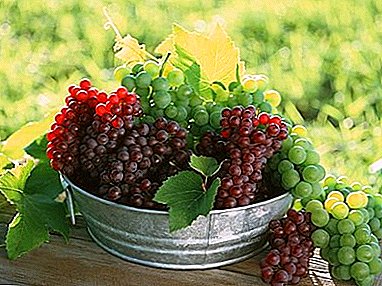 Signs of defeat:
Signs of defeat:- summer variegation due to the drying of the leaf plate from the edges to the central vein;
- shortened internodes on young shoots;
- extremely low intensity of shoot growth;
- spots appear on the shoots (light or yellow, in cold weather - black);
- comb comb dries, flowers and ovaries fall off;
- the life of an infected vine is a maximum of 3 years.
Control measures:
- careful selection of planting material at the time of laying the vineyard;
- phytoquarantine;
- to delay the development of the disease for six months: treating the vine (once every 2 weeks) with a solution of oxytetracycline that acts bacteriostatically (blocks the process of reproduction of bacteria);
- by increasing the concentration of the drug from 50 ppm to 500, you can extend the life of the plant up to 2 years.
Bacterial spotting differs from oidium damage in that it inseminates the outer part of the leaf, and bacteriosis penetrates deep into the affected part of the plant.
- Bacterial cancer - a terrible association is created by lumpy, fast-growing formations on the vines. This is a reborn tissue whose DNA has changed pathogenic bacteria.
The causative agent of the disease - Agrobacterum vitis can lurk in the body of a plant for a long time, getting there from the ground during the shelter for the winter, or in the event of abnormal circumstances: a sharp weakening of the plant due to thermal damage, mechanical damage or invasion of pests.
 The reason for the weakening of immunity are:
The reason for the weakening of immunity are:- frosty winter difficultly transferred by a plant;
- excess nitrogen in the soil, due to illiterate feeding;
- rodent wounds.
Damaged tissue as a signal by means of special secretions about what happened. Bacteria take this signal, actively grouping around the affected area. Signs of damage are mild or appear periodically, usually in dry seasons:
- shedding the ovary;
- decrease in growth rates for no apparent reason;
- appearance on the leaves of a drying edge;
- deterioration of the appearance and taste of the fruit;
- root loss by seedlings;
- stunted type of seedlings.
The disease becomes apparent to end of summer when a perennial vine appears on a perennial vine (recently it has been observed on annuals) of a fast-growing cone: first with the size of a bean, then with a large apple and more. The tumor grows in the tissue, depriving the plant of nutrients, which reduces its growth, fruiting, ripening fruits. The vitality of the plant goes to the growth of the tumor, the bush withers and dies.
Prevention
 Since a damaged plant is at greater risk of infection, it is necessary to carry out all agrotechnical measures with utmost care, trying to preserve the integrity of the surface of the vine and phytosanitary impeccability.
Since a damaged plant is at greater risk of infection, it is necessary to carry out all agrotechnical measures with utmost care, trying to preserve the integrity of the surface of the vine and phytosanitary impeccability.
Sanitary regulations:
- Do not plant a new plant to the place of uprooting the deceased from bacterial lesions (bacteria are stored in the ground and are waiting for a new owner). Uprooted plant to burn.
- Do not harvest planting material from the affected bush.
- Acquisition of planting material to carry out in checked special nurseries, excluding its bacterial infection.
- Before planting, incubate seeds for up to 40 minutes in hot (53 ° C) water or pickle with foundationol.
- Cuttings before planting to conduct thermotherapy for 30 hours in hot water (35 ° C).
- Pruning the bush to conduct quality pruners, disinfecting it with alcohol or copper sulfate solution before moving to another plant.
- Cut out the damaged part of the bush, saw cut to handle 2% solution of copper sulfate and garden pitch.
- Preparation of the bush for the winter to carry out without traumatic actions, preserving the integrity of the cover and excluding direct contact of the vine with the ground. Treat with nitrafen.
- In pursuit of the harvest, do not overload the plant, so as not to leave it for the winter weakened or injured.
- Consistently to prevent fungal diseases that weaken the immune system of grapes.
- It should be remembered that the removal of dew roots in the spring (katarovka) - a way to provoke bacterial cancer.
- Grapes do not like waterlogged soil, excessive watering - the risk of disease.
 Does grapes have immunity to pathogenic bacteria.
Does grapes have immunity to pathogenic bacteria.
The degree of damage to grape cancer is determined in the industry from 3 points:
- poorly responsive to pathogen pathogen - 1 point;
- having average stability - 2 points;
- most susceptible to the pathogen - 3 points.
The first group most often includes interspecific and intraspecific hybrids, such as:
- Aligote;
- Anapa early;
- Bastardo;
- Delight;
- Codrean;
- Muromets;
- Tayfi pink:
- Charas nutmeg;
- Crystal;
- Youth and others
Vulnerable varieties
Will consider most vulnerable varieties:
- Pearls Saba;
- White kishmish;
- Firstborn Magaracha;
- Rexavi;
- Favorite and others.
Among the table grapes there are improved, the seedlings of which were obtained in the sterile conditions of the laboratory, at the time of planting they are insured against bacterial infections ("Augustine"). But, in general, the grapes are completely resistant to bacterial expansion and, in particular, to cancer - not fixed.


 Berry bacteriosis is a disease of fruits from the earliest period of their formation (the integrity of the skin does not matter).
Berry bacteriosis is a disease of fruits from the earliest period of their formation (the integrity of the skin does not matter). Signs of defeat:
Signs of defeat: The reason for the weakening of immunity are:
The reason for the weakening of immunity are: